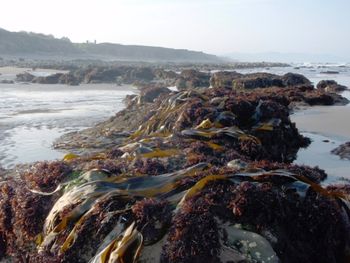Difference between revisions of "Portal:Marine Biodiversity/Selected Article"
| Line 1: | Line 1: | ||
| − | == | + | ==Diversity and classification of marine benthic algae== |
| − | [[ | + | [[image:See weed on a rocky outcrop.JPG|thumb|right|350px|caption|Algal canopy at low tide on the west coast of Irish Sea. Photo © EcoServe]] |
| − | + | Chlorophyllian photosynthesis is responible of almost all primary production at global | |
| + | level and represents the most fundamental process for the support and maintenance | ||
| + | of life on our planet. Organisms performing photosynthesis occur in every habitat in | ||
| + | which sunlight is available. Whereas vascular plants are largely responsible of | ||
| + | photosynthesis on land, in aquatic habitats this process is mainly perfomed by the | ||
| + | wide and heterogeneous complex of organisms called algae. | ||
| − | + | In the widest sense, algae are defined as oxygenic photosynthesizers other than | |
| − | + | embryophyte land plants (Cavalier-Smith, 2007<ref name = Cavalier> Cavalier-Smith, T. (2007). Evolution and relationships of algae: major branches of the tree of life. In Unravelling the algae: the past, present and future of algal systematics, eds J. Brodie and J. Lewis, pp 21-55. CRC Press, Boca Raton, London and New York. </ref>). In recent years our knowledge of these organisms has greatly advanced, thanks to new types of data (mainly electron microscopy observations and DNA sequence data). Based on these data, we know now that algae represent an artificial and unnatural agglomeration of very different | |
| + | organisms, sharing the only common characteristic of living in aquatic habitats. Algae | ||
| + | living in the sea are typically subdivided in plankton (the complex of microscopic | ||
| + | algae not visible with unaided eye, which live floating in the water) and benthos (the | ||
| + | collectivity of the algae that live attached to the sea bottom). [[Diversity and classification of marine benthic algae|'''More...''']] | ||
Revision as of 11:44, 31 July 2009
Diversity and classification of marine benthic algae
Chlorophyllian photosynthesis is responible of almost all primary production at global
level and represents the most fundamental process for the support and maintenance
of life on our planet. Organisms performing photosynthesis occur in every habitat in
which sunlight is available. Whereas vascular plants are largely responsible of
photosynthesis on land, in aquatic habitats this process is mainly perfomed by the
wide and heterogeneous complex of organisms called algae.
In the widest sense, algae are defined as oxygenic photosynthesizers other than embryophyte land plants (Cavalier-Smith, 2007[1]). In recent years our knowledge of these organisms has greatly advanced, thanks to new types of data (mainly electron microscopy observations and DNA sequence data). Based on these data, we know now that algae represent an artificial and unnatural agglomeration of very different organisms, sharing the only common characteristic of living in aquatic habitats. Algae living in the sea are typically subdivided in plankton (the complex of microscopic algae not visible with unaided eye, which live floating in the water) and benthos (the
collectivity of the algae that live attached to the sea bottom). More...- ↑ Cavalier-Smith, T. (2007). Evolution and relationships of algae: major branches of the tree of life. In Unravelling the algae: the past, present and future of algal systematics, eds J. Brodie and J. Lewis, pp 21-55. CRC Press, Boca Raton, London and New York.
